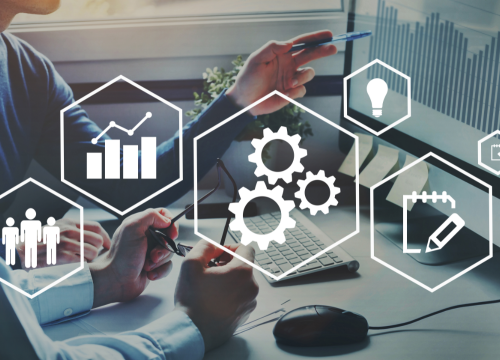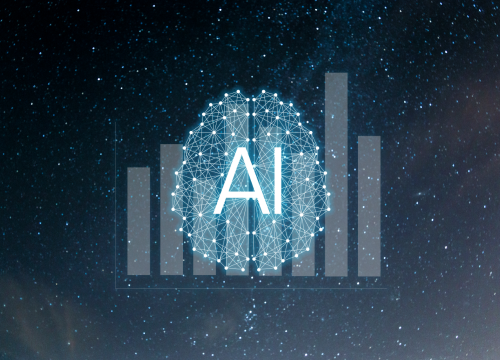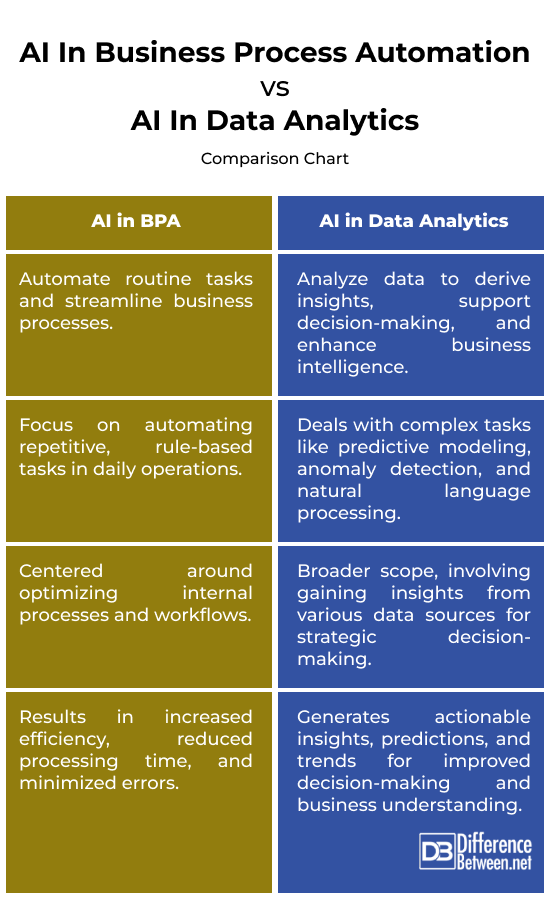Difference Between AI in Business Process Automation and AI in Data Analytics
It’s fascinating to observe how automation has evolved over the years, becoming an essential element for the success of modern enterprises. The integration of artificial intelligence (AI) has reshaped various facets of business operations. Two prominent domains where AI plays a transformative role are business process automation (BPA) and data analytics. While both harness the power of AI, they serve distinct purposes.
In this article, we’ll discuss the differences between AI in business process automation and AI in data analytics, shedding light on their unique functionalities and the impact they wield on organizational efficiency and decision-making processes.

AI in Business Process Automation
AI isn’t just about technology doing tasks; it’s about making businesses more agile, accurate, and forward-thinking. AI has emerged as a revolutionary technology in business process automation (BPA) to optimize the flow of work. It’s like having a super-smart assistant that makes our work processes smoother and more efficient. Imagine you have a personal helper who not only understands what needs to be done but can also do it faster and with fewer errors.
In simple terms, AI involves using smart computer programs to handle repetitive and rule-based tasks that were traditionally done by humans. It’s like delegating the routine stuff to a digital teammate, freeing up human workers for more creative and complex tasks.
For instance, in a retail business, AI can analyze customer buying patterns to predict what products might be popular in the upcoming season. This helps businesses make smarter decisions about inventory and marketing strategies.

AI in Data Analytics
AI plays a crucial role in data analytics, revolutionizing the way organizations extract insights from large datasets. It refers to a subset of business intelligence that uses machine learning techniques to identify patterns and discover insights in data. AI algorithms can automatically identify and rectify inconsistencies, errors, or missing data in large datasets. This ensures that the data used for analysis is accurate and reliable.
The role of AI in data analytics is multifaceted, encompassing data processing, pattern recognition, predictive analytics, natural language processing, visualization, and optimization. By harnessing the power of AI, organizations can derive meaningful insights from their data, make informed decisions, and gain a competitive edge in today’s data-driven business landscape.
In some cases, AI systems can make automated decisions based on real-time data analysis, contributing to faster and more agile decision-making processes. AI can identify inefficiencies in business processes by analyzing data, leading to streamlined operations and resource optimization.
Difference between AI in Business Process Automation and AI in Data Analytics
Primary Objective
The primary goal of AI in BPA is to automate and streamline business processes. BPA is often applied to tasks like data entry, document processing, and workflow optimization. It focuses on the automation of routine, rule-based tasks to improve efficiency, reduce errors, and enhance overall operational effectiveness.
In contrast, the primary objective of AI in data analytics is to analyze and derive meaningful insights from the data. It involves using AI algorithms to identify patterns, trends, and correlations within large datasets.
Nature of Tasks
BPA is typically applied to automate repetitive, mundane, and rule-based tasks that are part of everyday business operations. It aims to reduce the burden of manual labor on tasks that follow predefined rules and procedures.
AI in data analytics deals with more complex and varied tasks, such as predictive modeling, anomaly detection, and natural language processing. It involves interpreting and making sense of unstructured data, discovering trends, and extracting actionable insights from diverse datasets.
Scope of Application
The scope of AI in BPA is often centered around optimizing internal processes and workflows. It is applied to improve operational efficiency, reduce costs, and enhance the overall productivity of business operations.
AI in data analytics has a broader scope that extends to gaining insights from various data sources. It is used to analyze customer behavior, market trends, and other relevant data to support strategic decision-making, product development, and marketing strategies.
Output and Outcome
The output of AI in BPA is often manifested in increased efficiency, reduced processing time, and minimized errors in routine tasks. The outcome is a more streamlined and agile business operation.
The output of AI in data analytics is the generation of actionable insights, predictions, and trends from data. The outcome is improved decision-making, strategic planning, and a deeper understanding of the factors influencing business performance.
AI in Business Process Automation vs. AI in Data Analytics: Comparison Chart

Summary
While both AI in BPA and data analytics leverage artificial intelligence, their focus, tasks, scope, and outcomes differ. AI in BPA aims to automate and optimize business processes, while AI in data analytics is geared towards extracting valuable insights from data to support strategic decision-making and business intelligence. The role of AI in data analytics is multifaceted, encompassing data processing, pattern recognition, predictive analytics, natural language processing, visualization, and optimization.
FAQs
How can AI and data analytics be used to automate business processes?
In business process automation, AI can identify patterns, make predictions, and continuously optimize workflows. Data analytics, on the other hand, provides valuable insights through the examination of historical and real-time data, aiding in informed decision-making and process improvement.
What is the difference between AI and process automation?
AI refers to the simulation of human intelligence in machines, enabling them to perform tasks that typically require human cognition. Process automation, on the other hand, involves using technology to perform repetitive tasks or processes without human intervention.
What is the difference between artificial intelligence and data analytics?
Artificial intelligence is a broader concept that involves machines mimicking human intelligence, including learning from experience (machine learning), problem-solving, and understanding natural language. Data analytics, on the other hand, specifically revolves around examining raw data to draw conclusions and make informed decisions.
What is the difference between data automation and artificial intelligence?
Data automation involves the use of technology to perform tasks related to data management, such as data entry, extraction, and transformation, without human intervention. Artificial intelligence goes beyond automation by enabling machines to learn from data, recognize patterns, and make decisions.
How is AI used in business analytics?
Machine learning algorithms, a subset of AI, can identify patterns, trends, and anomalies in data, enabling more accurate predictions and actionable insights. AI-powered analytics tools can automate data processing, classification, and interpretation, providing a deeper and more efficient analysis of complex datasets.
How is AI used in business analytics?
In business analytics, AI is employed to enhance decision-making processes and gain insights from business data. AI algorithms can analyze historical and real-time data to identify trends, forecast future outcomes, and optimize business strategies.
- Difference Between Caucus and Primary - June 18, 2024
- Difference Between PPO and POS - May 30, 2024
- Difference Between RFID and NFC - May 28, 2024
Search DifferenceBetween.net :
Leave a Response
References :
[0]Liebowitz, Jay. Data Analytics and AI. CRC Press, 2020.
[1]Taulli, Tom. The Robotic Process Automation Handbook: A Guide to Implementing RPA Systems. Apress, 2020.
[2]Burk, Scott, and Gary D. Miner. It’s All Analytics!: The Foundations of Al, Big Data and Data Science Landscape for Professionals in Healthcare, Business, and Government. CRC Press, 2020.
[3]Image credit: https://www.canva.com/photos/MADZH-lsnLc-concept-augmented-analytics-business-analytics-and-financial-technology-concept-ai-artificial-intelligence-and-smart-analytics-data-science-learning-machine/
[4]Image credit: https://www.canva.com/photos/MADxC7YDvEw-automation-and-optimisation-concept-business-process-/
